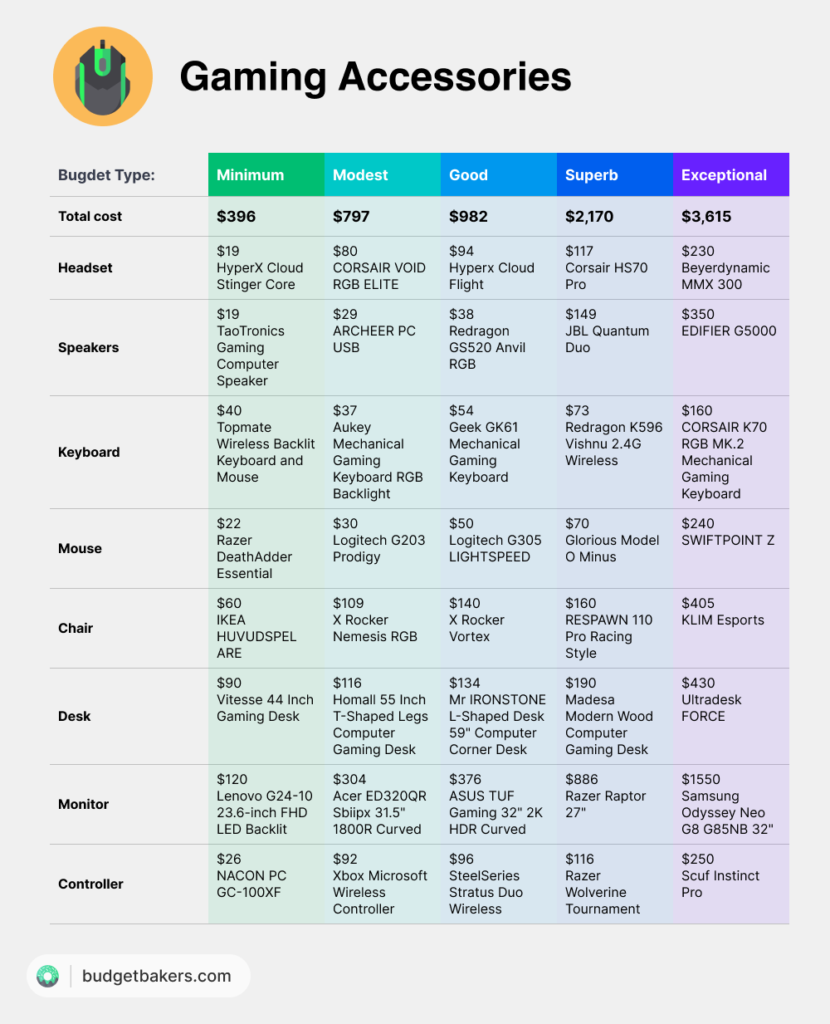Open any newspaper to read about how spending habits have changed over the past few years. They will tell you that spending on in-person retail, restaurants, and services were all down massively in 2020 and slow to recover since. Spending on movie streaming services, on the other hand, skyrocketed.
One thing they probably won’t mention is one of the emerging leaders in terms of spending among zoomers and millennials: video games.
In this post, we’re going to talk about how the gaming industry makes money, and how much typical gamers spend on gaming. Then we’ll share some budgeting tips for different types of gamers who are looking for a little more financial discipline to go with their hobby.
So, let’s get started:
How Big is the Gaming Industry?
You may have seen a news item recently which said that games spending is down in 2022. However that’s mostly because game spending far exceeded expectations in the two years prior. In fact video game spending per year has risen by at least 38% since the start of the Covid 19 pandemic. Most of those gains occurred in 2020 alone, with an over 26% year on year increase in the United States, and similar numbers internationally.
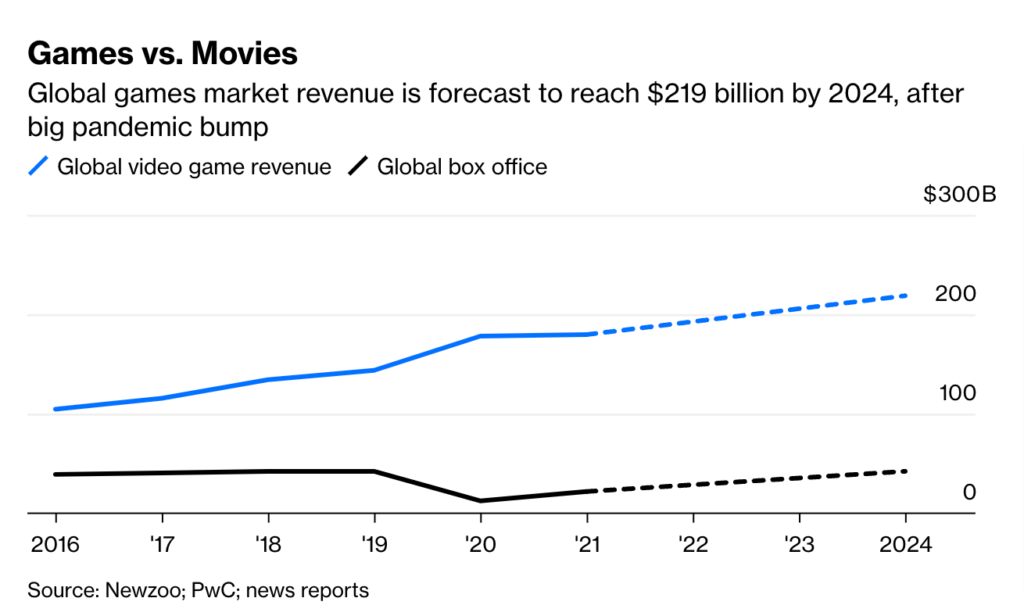
Gaming in America is worth $52bn in gross sales per year, making it a bigger industry than mainstream film and music put together. In fact, at $180bn worldwide in 2021 and a projected $218bn in 2024, gaming is approaching the size of the international television market, which is worth just about $40bn a year more than gaming as of 2021.
And, it need not be said, the television industry is not growing at 25% or more a year.
How The Gaming Industry Makes Money
While these numbers are impressive, it’s worth going into some details to understand how gaming has become such a powerhouse, economically.
From Niche to “AAA”
For decades, from the 1970s to the 2000s, video games were a small and reasonably profitable industry that made money largely from the sales of casual games played at home, as well as a niche market for Electronic Arcades (now all but disappeared).
In those days, the production budgets for games could be counted in the thousands to hundreds of thousands of dollars, and titles were often made by small dedicated teams who worked together on many projects. Game studios could produce many titles a year, and probably worked on more than one title simultaneously.

As the industry grew and became more complex, and as technology improved, the size and complexity of games also grew. Today, so called “Triple A” (AAA) titles such as Call of Duty, Final Fantasy, or Grand Theft Auto, often installments of long-running series, have production budgets larger than some big budget films.
To some degree, the niche game industry of small studios producing niche titles does still exist, but it is dwarfed in size by the massive studios that produce multi-billion dollar titles like Call of Duty, Dark Knight, GTA, Halo, The Witcher, and others.
In fact, the world’s most expensive game, which is currently still in development, but has been released as an Alpha version, has cost its producers an estimated $400m to make. That will make the recent abject failure of the previous record holder for most expensive game, CD Project Red’s Cyberpunk 2077, look cheap at just over $300m.
Today these tiles and their sometimes long-running expansion packs and online components cost upwards of $100 per game, and can take dozens or even hundreds of hours to play through. These represent, for most consumers, the biggest expense in gaming, aside from the gaming console or computer equipment they are played on.
These so called “pay to play” games are focused on developing strong gameplay mechanics and an interesting story driven by excellent performances and great writing. But that’s not how all gaming studios make money…
E-Sports and Pay to Win

The other, and far faster growing side of gaming is e-sports: loosely defined as games in which gameplay skill and experience are critical to success, and which are usually played competitively, either online or in person.
While e-sports have actually been around for decades, with competitions in arcade games and even home-console titles like Super Smash Bro’s Melee being popular among a small subculture of gamers who never quite left their parents’ basements, e-sports of today are mainstream.
Running the gamut from sports-simulator games like the FIFA series, to racing, to strategy games, e-sports now encompasses a huge part of the gaming industry, with all the attending money in sponsorships, merchandise, and advertising. Professional gamers now make a living playing games – often with a great deal of skill and experience.
While it may sound fun to have a job playing video games, just like any job, this one is also not without its drawbacks, as competition is fierce, and the pressure to cheat or take shortcuts is the same as in any competitive endeavor.
And of course, like in any other sport, the producers of these games make money from punters who want to emulate their favorite players, and will spend money to become more like them. Whether that means paying for expensive expansions and equipment to play their favorite games, or dropping in-game currency to get ahead of other players, e-sports extracts a significant income from its fan base.
And that, ultimately, is how e-sports make money.
Rewarding or Addicting?
Games have long been the subject of controversy. There have always been those who have criticized e-gaming as pointless, stupid, and even addictive and life destroying.
Others have argued that gaming represents the future of storytelling, and that its rise shows that gaming can represent the best of what modern culture has to offer. These people point out that the reward of a great game is on par with that of a great novel, or a film or television series, but even better because you have to earn the experience through gameplay and discovery.
Like anything else, it’s ultimately a business. Some money will be made selling content to casual players looking for a great story, and some money will be made from e-sports players, some of whom are addicted to the games they love, and will do anything to improve their gameplay experience, including spending real money on things that most of us would never consider valuable.
The dichotomy between these two groups has become so severe that it’s become the subject of many memes, which often point out that the very same game can have two completely separate audiences: one in e-sports and the other casual.
Where All The Money Goes
As part of our research for this post, we looked into the myriad of subscription services available today to gamers, and we will make that table available to you here.
As you can see, many of the streaming services overlap in what and how much is offered, meaning it’s likely many consumers are paying twice or even more for the same content.
On the other hand, maybe there will be something you’ll discover here that you didn’t know about yet:
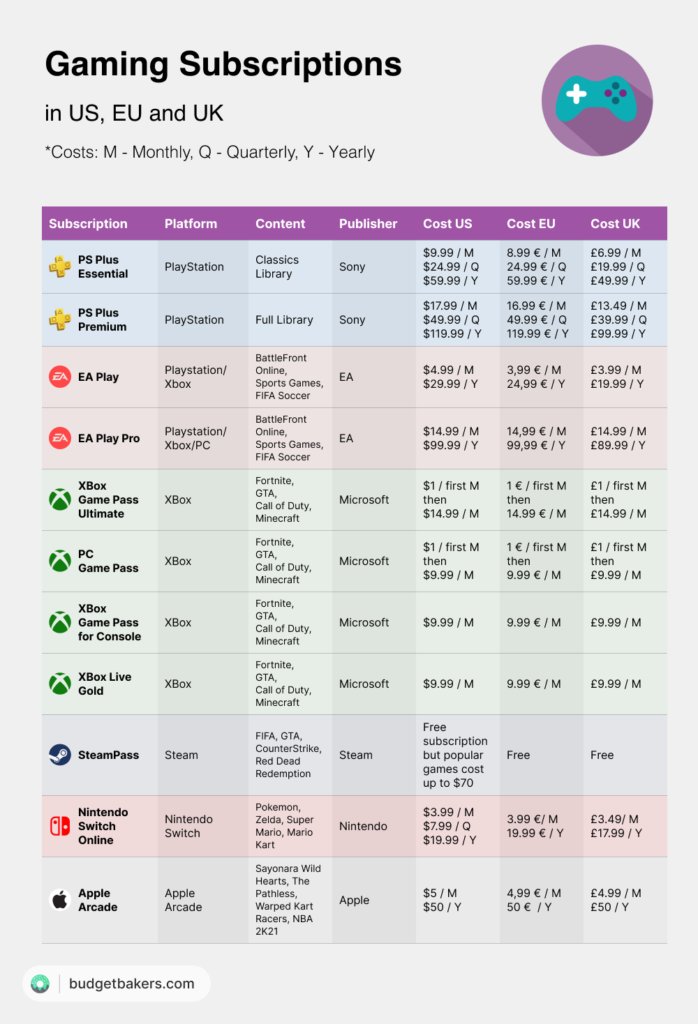
Typical Gaming Budgets
Given all that, what’s a reasonable amount for you to be spending on gaming? Well, that depends on what kind of a gamer you are. After all, how much you can invest in a hobby depends on how important that hobby is to you, and how much time you have for it.
We’ve created sample budgets for 3 types of gavmers: The student gamer, the casual gamer, and the pro gamer. Additionally, we have broken down the recurring costs and the one time costs for each gaming category, and calculated the percentage of your yearly budget that it takes to maintain the hobby.
The Student Gamer Budget

As you can see, there are many options for the student budget. Once you’ve got your primary gaming device, options for subscription “pay to play” games are pretty good and affordable. There are options for fans of sports games, such as EA Online, as well as for fans of RPGs and more content heavy games offered by game libraries from the major consoles. There is also Apple Arcade for the mobile gamer.
We assume in this scenario that as a student, you’ve got more free time than you have money to play with, so your choices are reduced to just the most basic subscription bundle options.
One of the real budget killers for students is in-game upgrades that aggressively target younger gamers. It’s best to avoid these, and the games that heavily depend on them to make money. These games are designed to lure you in with free-to-play fun, which quickly turns expensive as you may find the game frustrating and tedious without these paid add-ons.
A good policy if you’re on a budget is to only play games you’re willing to pay for. That may sound counter-intuitive, but a game that justifies its cost with money up front is less likely to be designed to drain your bank account later on. While sometimes these gimmicks can’t be avoided, you can minimize their impact by adopting a zero-tolerance policy for any “pay to win” model games.
For all these reasons, we’ve identified EA Play as the best value for money for a student gamer. EA play offers a range of games, including sports games and action RPGs such as Star Wars, Fallen Order and Anthem. EA’s huge range of shooters like the Battlefield and Battlefront series offer a lot of depth and value for the money, and their sports games are of course top of the line. There is also the Need For Speed series for racing fans to enjoy.
The Casual Gamer Budget
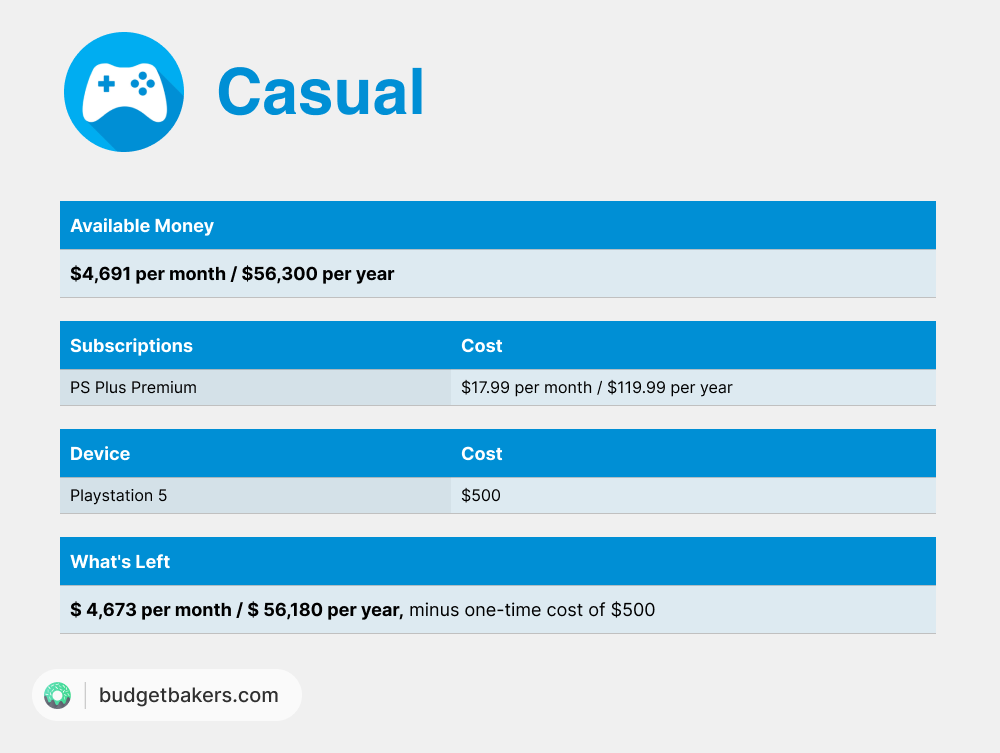
Unlike the student, who has more time than money, the casual gamer lacks the time to invest in games, but has the money to afford them. They are a professional, with a decent income, and may have children (this becomes important later). They may own a console, or alternatively they use a powerful tablet or a work computer at home.
For the casual gamer, flexibility is important. Games should be engaging but not all consuming. E-sports is less attractive because of the time commitment, and the casual gamer is less likely to value MMORPGs or online competitive games because the audiences for these games are younger. Thus the casual gamer finds content-light games to be the best option. These games are simple shooters or basic strategy games that can be played from session to session, and don’t require the massive commitment of time a story-heavy RPG requires.
For these reasons, we identified Sony’s PS Plus Premium subscription package for the Playstation as the best bet for a casual gamer. There is also one more big advantage with Sony, which is their huge back catalog of kid friendly games. For those millennials who have young children at home, a catalogue of 7+ rated games is a life saver on a rainy day! Take that from someone who knows.
The best deal on Playstation Plus Premium is for $120 a year or thereabout. And for that $10 a month (paid yearly) you get dozens of high profile AAA titles, action RPGs, open world games, and a huge library of engaging children’s games that your kids will love. If anything, the embarrassment of riches in the Sony library will leave you feeling like you don’t have the time to try all the things you’d like to.
Of course, brand new AAA titles aren’t going to be available, and most sports games won’t be in the library, but if you’re a casual weekend gamer, you shouldn’t really be playing the latest story games anyway – better to wait until a game has been out for a few years, all the bugs have been fixed, and walkthroughs exist online to help you out of any trouble spots. Win/Win.
The PC Master Race

Enough of filthy casuals with their consoles. No gaming budget post would be complete with a discussion of the “PC Master Race.” These are the gamers who brook no compromises with their equipment, and see the higher performance, most advanced and latest technology to enhance their gaming experience.
Gaming PC and Gaming Accessories
There are levels to the madness of gaming obsession. In this sample budget, we break down the levels of PC game immersion and give you a tiered view of the investments a PC gamer must make in order to experience games on the ultimate level. We’ve broken down the costs into 5 tiers, from Minimum to Exceptional:
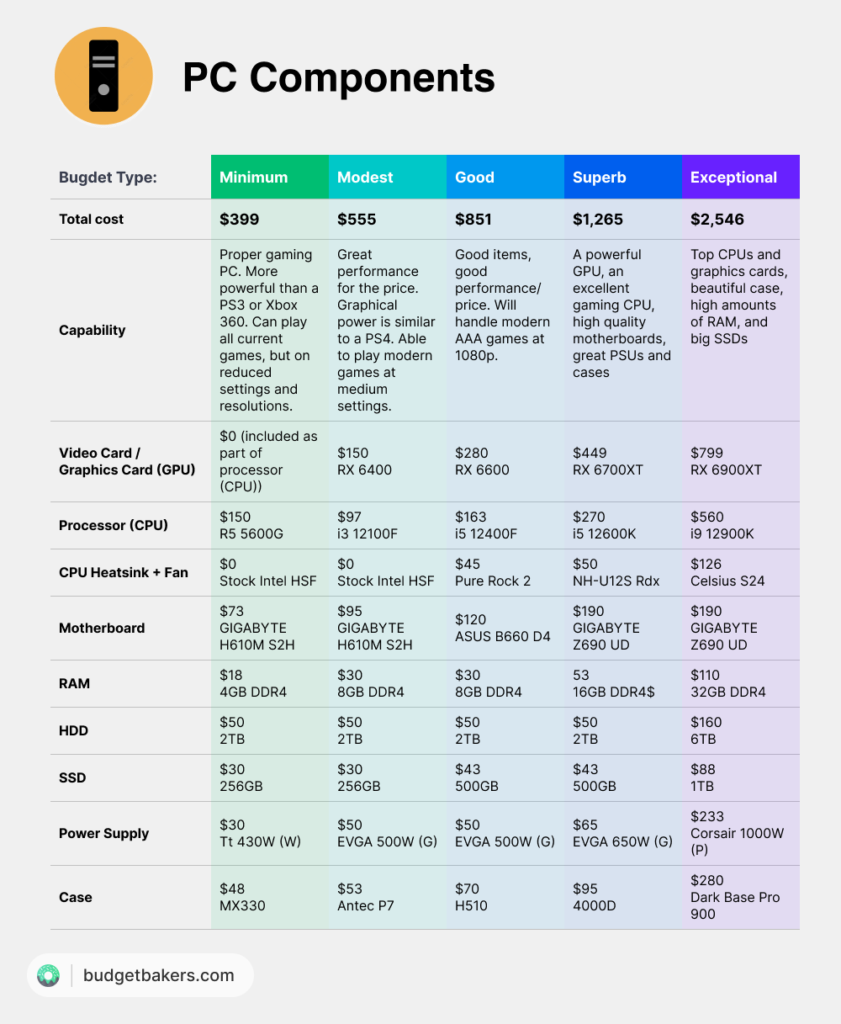
That’s just for computing equipment. PC Master Race gamers also want the very best in peripherals and other items that provide the most comfortable and conducive conditions for pro-gaming life. Here’s a breakdown of the costs in those same tiers:
